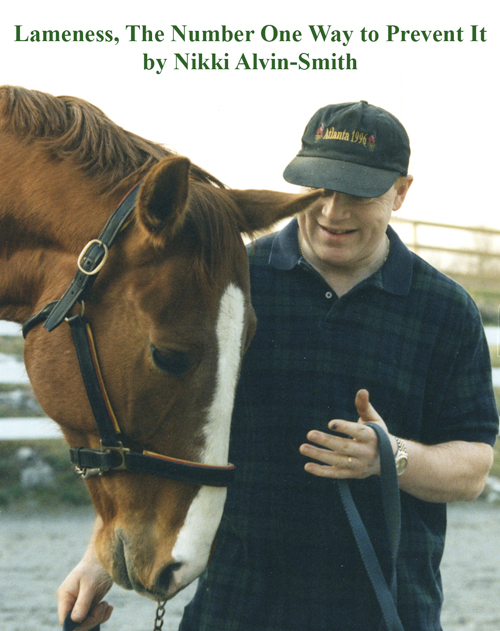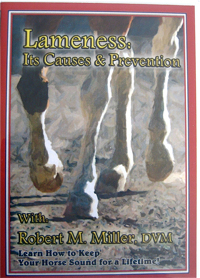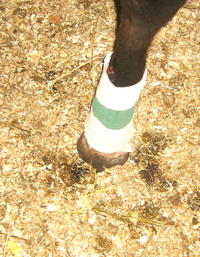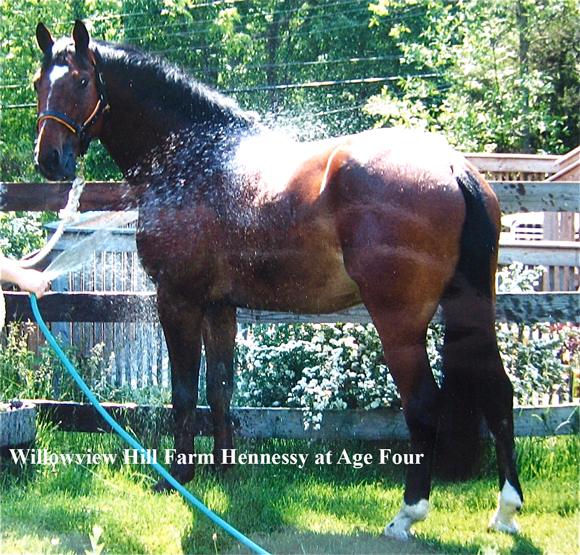Lameness, The Number One Way to Prevent It
by Nikki Alvin-Smith

I recently purchased the new DVD Lameness, It's Causes and Prevention and wanted to pass along some interesting facts that the highly respected Dr. Robert Miller presented.
When you think of all the thigs that can cause lameness such dangerous environments with barbed wire fences and steep hills, infection, genetic issues and the myriad of others, the first thing you probably don't think about is working the horse at too young an age.
According to Dr. Miller if you took all the other possible causes of lameness in the horse and added them all together, they would not total those caused by starting a horse too young.
A friend recently told me a story of a lovely eighteen month warmblood colt that was already under saddle and had been lightly ridden. This was by an experienced dressage rider who really should know better. The growth plates haven't even closed yet. Seriously. As I also know the breeder who produced the horse I feel bad as I know just how much thought, energy, and the loss of the mare and orphan care that had already been a part of his life and hers had cost both emotionally and financially. As a fellow horse breeder, I am aghast. Perhaps when our foals don't sell before we start them at three and a half, that is a good thing.
In our experience starting youngsters it is true that by the time they are three and you get on them, they may have a little more option or likelihood to throw you on the floor. However much ground work you do, there are always the quirky ones with their own opinions. So I guess sitting on something that can in no way support your weight and has less option to throw you off is the reason for this stupidity.
Or perhaps it is the zest for the almighty dollar. You can bring your baby to market earlier.
In certain disciplines such as cutting the futurity ages are ridiculous. Add to that the working of a cutting horse on a regular basis on deep competition footing and naturally it is a disaster. Someone needs to change up the futurity age groups and take some responsibility.
Dr. Miller also gave a very good example of natural hoof care. It is something we practice at our farm at Willowview Hill. It is true as he also states that some horses need shoes and corrective shoeing as they develop. I was pleased to see the balanced viewpoint. I do think that people who trim feet for other people should be licensed. Come to that I also think dentists/chiropractors and acupuncture therapists should be too. Many horse owners do not know just how much damage can be done by the untrained or unregulated folks that pick up a set of teeth float tools or foot rasps and start filing. There is a reason for the long and exact education a doctor of veterinary medicine completes. Let's face it, would you go to a dentist that had just been out to the shop and bought themselves a set of dentistry tools. We use Dr. Todd Behre, who is a specialist dentist and a qualified veterinarian. He comes in with his power float and does a neat job, and I like knowing he understands the full aspects of my horses mouths.
I'm not saying there aren't some awesome therapists out there, that do a solid job. But like anything else it pays to respect a profession. I've made my share of mistakes over the last 30 years or so of horse ownership. Sometimes trying to save a dollar or too. Sometimes taking advice from people who I shouldn't even be asking for advice when I don't know their own education well enough.
This is a good time for me to reflect on the wise choice of letting horses grow up before we start riding them. Incidentally, for good measure we give our horses time off once we've sat on them at age three and a half. We do not over longe them first either. As they come into the Spring of their fourth year they are started back under saddle all the way from the beginning. No pounding. Just sweet, short lessons.
We've had horses go on to be great dressage mounts into their twenties. I believe this patience is just one of many reasons for sure, but a very important one.
So I think on this measure of patience, energy, emotion and responsibility that breeding a horse surely entails as I head out to the barn to turn out one of the yearlings, who lacerated her front pastern slightly and is now sporting vet wrap in green covering an extremely professionally cleaned, clipped, and treated wound. Happily the wound is not serious and the filly will be fine. It was an errant accident. They do happen. No barbed wire here or evident reason for the injury, as there often isn't.
 As I stood and watched our vet, Dr. Liz Fish of Shadowrock Equine Clinic in Oneonta, kneeling and carefully sculpting the epidermal tissue, debriding a small patch of tissue that had already started to granulate and tending with such care to this hopefully 'one day to be' super dressage or event horse, it was crystal clear to me that not just us as horse owners, but the professionals that attend to the horse's needs all put a significant piece of themselves in to every horse. As a trainer I owe them all. So I must be responsible and look at the long term future of the horse and not succumb to the market pressures to have the horse doing flying changes by five. And I don't mean lead swaps.
As I stood and watched our vet, Dr. Liz Fish of Shadowrock Equine Clinic in Oneonta, kneeling and carefully sculpting the epidermal tissue, debriding a small patch of tissue that had already started to granulate and tending with such care to this hopefully 'one day to be' super dressage or event horse, it was crystal clear to me that not just us as horse owners, but the professionals that attend to the horse's needs all put a significant piece of themselves in to every horse. As a trainer I owe them all. So I must be responsible and look at the long term future of the horse and not succumb to the market pressures to have the horse doing flying changes by five. And I don't mean lead swaps.
Every horse owner knows the misery of finding out their horse has a permanent medical issue that will prevent the horse from reaching its potential and possible from them ever reaching their own. And if the lameness or issue isn't permanent look at the expense and time spent. Not to mention the horse trying to tell you he hurts by tossing you skyward or balking at his work because perhaps you weren't listening resulting in you suffering alongside him.
I once recall an Olympic dressage rider stating something to the effect that for every Grand Prix horse he made, and he made some lovely ones, he threw away six. What!! Yes, that was his batting average. We all know there are lots of variables, but you have to wonder how many horses just don't make it because of starting them too young.
Look at the auction process in Europe. Sometimes you get lucky and sometimes you don't. This horse is still going well at eighteen, so that is a success story. But we denied a lot of horses before we carefully selected him from around one hundred twenty options and then we gave him a year once he arrived of very light work to let him mature. Here he is at four, enjoying a Spring bath. He narrowly avoided the stallion testing rigor in Europe and was gelded after a few breedings there. Whenever I entered Dr. Brunkmann's office in Verden I think he dreaded seeing me. I'd go over the Xrays and reports before I'd even entertain sitting on the horse and was not impressed when the young horses were already showing signs of trauma to their joints and soft tissues and was not shy to tell him what I thought about it.
He narrowly avoided the stallion testing rigor in Europe and was gelded after a few breedings there. Whenever I entered Dr. Brunkmann's office in Verden I think he dreaded seeing me. I'd go over the Xrays and reports before I'd even entertain sitting on the horse and was not impressed when the young horses were already showing signs of trauma to their joints and soft tissues and was not shy to tell him what I thought about it.
Due diligence will work for most of the time when you are purchasing a horse, but I would love it if in general horses were not started at two and pounded at three. Can you imagine how many less weary rescue owners there would be as a result. We all know where damaged horses end up, and that's if they are lucky. and to look to what they are perpetuating by their judging and set up of futurities, their demands for a horse at third level by four or five, their impatience. And thanks to Dr. Miller for some great advice. The end of the DVD highlighted some of the newest treatments available, and Dr. Shane Miller was eloquent in his report. But wouldn't it be nice if those modalities were not required for quite so many horses.


